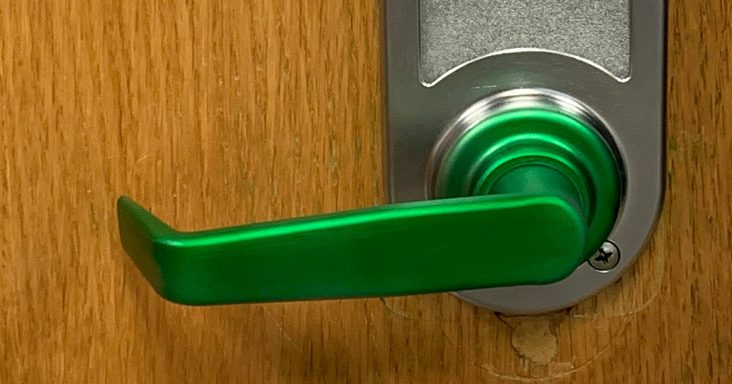UA researchers develop long-lasting disinfectant spray
by August 5, 2020 8:16 am 2,663 views

Researchers with the University of Arkansas and the University of Arkansas for Medical Sciences (UAMS) have developed a disinfectant spray that can last for up to 50 touches before it needs to be reapplied.
The long-lasting spray was created using plant-based nanotechnology and contains a green dye that, when it fades, will show another application is needed.
“If it’s green, it’s clean,” said John Moore, a UA doctoral student in chemical engineering and part of the team researching the spray. Moore is also CEO of Fayetteville-based Nanocellutions, established in April by the team, including Jamie Hestekin, Peter Crooks and Soma Shekar Dachavaram. Hestekin is a professor of chemical engineering at the UA, and Crooks and Dachavaram are with UAMS.
Work that led to the development of the spray started in 2015 as part of a $20 million National Science Foundation Track 1 project led by Min Zou, mechanical engineering professor, and Steve Stanley of the Arkansas Economic Development Commission.
Moore explained that COVID-19 has led people to help combat the virus. Before the pandemic, he worked to develop a spray to prevent the spoilage of meat and produce. The development of the spray technology began about two years ago, Moore said. In February, researchers started to develop the disinfectant spray, based on the previous research.

“Instead of just using it to preserve meat or vegetables or fruit or other items needed to be preserved and kept clean, we thought, ‘Why don’t we use this as an antimicrobial spray for general high-contact surfaces that need to be preserved from people, and people to help them preserve themselves from each other?’” Moore said. “And that’s when it took off.”
The spray comprises nano-sized cellulose, or components of plants or trees, a wax and a disinfectant. Nano-sized cellulose is typically less than 100 nanometers in diameter and several micrometers in length. A nanometer and micrometer are one-billionth and one-millionth of a meter, respectively. By comparison, a sheet of paper has a thickness of about 100,000 nanometers or 100 micrometers.
The company is looking to work with a Northwest Arkansas manufacturer to produce the spray and other products using the technology, such as wipes, Moore said. Before the spray can be sold, it must receive approval from the Federal Trade Commission and U.S. Environmental Protection Agency. He expects this to take place within five to nine months. The spray might initially be sold to businesses, schools or hospitals looking to show cleaned surfaces, such as door handles, shopping carts or point of sale devices. It also might be available online or in stores.
Asked how the spray might compare to traditional disinfectants such as Lysol or Clorox, Hestekin noted its ability to clean surfaces and keep them clean. Traditional disinfectants are good at destroying viruses, but after someone with a virus on their hands touches the cleaned surface, it would become infected again.
The spray is expected to be tested on COVID this fall and is being developed to destroy viruses that are even more difficult to quash than COVID, he said.
The spray could impact the recovery process in the pandemic.
“When the current lockdowns end, there will be a need for the public to feel safe going out again,” Hestekin said. “Since it is known that COVID-19 can survive a significant amount of time on surfaces, a surface coating that works on doorknobs, countertops, etc., is needed to make the public feel safe touching these surfaces without risk of being infected.”
While the spray would not replace maintaining good hygiene like hand washing, it would allow for an additional means to combat the spread of the virus.
“The goal is to provide a quick-drying surface coating material that can be easily handled and applied by large companies and consumers,” Moore said.
The National Science Foundation recently awarded $194,000 to support the researchers’ work. They are working with Christa Hestekin, an associate professor and recipient of the Ansel and Virginia Condray Endowed Professorship in Chemical Engineering. The UA Chancellor’s Commercialization Fund also supports the project.
